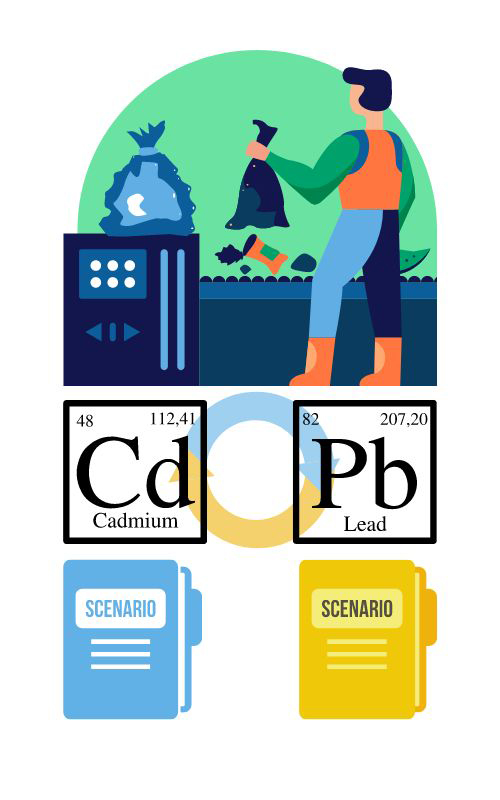Cadmium and lead flow analysis as a decisions support data for waste management Scientific paper
Main Article Content
Abstract
Striving for EU membership, the Republic of Serbia must adjust its waste management practices to comply with EU directives, including targets to reduce biodegradable waste disposal in landfills, as outlined in its Waste Management Program 2022–2031. Cadmium and lead, two highly toxic heavy metals, that are present in municipal solid waste, can pose high environmental and human health threats if not properly managed. The research evaluates how different technologies for biodegradable waste treatment influence the transformation of cadmium and lead flows through waste management systems. Hence, two waste management scenarios were modelled and developed for the Republic of Serbia, where the flows of cadmium and lead are monitored. The results indicate the differences between quantities and concentrations of cadmium and lead emitted in environmental media, thus confirming the various impacts of different waste technologies on achieving the vital goal of waste management – protection of the human health and the environment. The research concludes the crucial role of the versatile approach, where the quality of waste management outputs is highlighted.
Downloads
Metrics
Article Details

This work is licensed under a Creative Commons Attribution 4.0 International License.

Authors retain copyright and grant the journal right of first publication with the work simultaneously licensed under a Creative Commons Attribution license 4.0 that allows others to share the work with an acknowledgement of the work's authorship and initial publication in this journal.
References
N. Stanisavljevic, P. H. Brunner, Waste Manage. Res. 37 (2019) 665 (https://doi.org/10.1177/0734242X19853677)
C. Roithner, H. Rechberger, Waste Manage. 105 (2020) 586 (https://doi.org/10.1016/j.wasman.2020.02.034)
B. Puyuelo, J. Colón, P. Martín, A. Sánchez, Waste Manage. 33 (2013) 1381 (https://doi.org/10.1016/j.wasman.2013.02.015)
The government of the Republic of Serbia, Waste management program of the Republic of Serbia for the period 2022-2031, 2018 (in Serbian)
P. H. Brunner, H. W. Ma, J. Ind. Ecol. 13 (2008) 11 (https://doi.org/10.1111/j.1530-9290.2008.00083.x)
G. Doberl, R. Huber, P. H. Bruner, M. Eder, R. Pierrard, W. Shconback, W. Fruhwirth, H. Hutterer, Waste Manage. Res. 20 (2002) 311 (https://doi.org/10.1177/0734247X0202000402)
M. L. Mastellone, P. H. Brunner, U. Arena, J. Ind. Ecol. 13 (2009) 735 (https://doi.org/10.1111/j.1530-9290.2009.00155.x)
U. Kral, PhD Thesis, Vienna University of Technology, Vienna, 2014 (https://publik.tuwien.ac.at/files/PubDat_229212.pdf)
Heavy metals in the environment, L. K. Wang, J. P. Chen, Y.-T. Hung, N. K. Shammas, Eds., Taylor & Francis Ltd., Oxfordshire, 2009 (ISBN 9781138112575)
S. J. Burnley, Waste Manage. 27 (2007) 327 (https://doi.org/10.1016/j.wasman.2005.12.020)
U. Kral, P. H. Brunner, P. C. Chen, S. R. Chen, Ecol. Indic. 46 (2014) 596 (https://doi.org/10.1016/j.ecolind.2014.06.027)
U. Kral, L. S. Morf, D. Vyzinkarova, P. H. Brunner, J. Mater. Cycles Waste Manage. 21 (2019) 1 (https://doi.org/10.1007/s10163-018-0786-6)
N. Stanisavljevic, P. H. Brunner, Waste Manage. Res. 39 (2021) 1437 (https://doi.org/10.1177/0734242X211058344)
P. H. Brunner, H. Rechberger, Practical Handbook of Material Flow Analysis, Lewis publishers, Boca Raton, FL, 2004 (https://doi.org/10.1016/B978-1-85617-809-9.10003-9)
N. Stanisavljevic, P. H. Brunner, Waste Manage. Res. 32 (2014) 733 (https://doi.org/10.1177/0734242X14543552)
A. Allesch, P. H. Brunner, Environ. Sci. Technol. 51 (2017) 540 (https://doi.org/10.1021/acs.est.6b04204)
U. Arena, F. Di Gregorio, Resour. Conserv. Recycl. 85 (2014) 54 (https://doi.org/10.1016/j.resconrec.2013.05.008)
O. Cencic, H. Rechberger, J. Environ. Eng. Manage. 18 (2008) 440
Regulation on emission limit values of pollutants in water and deadlines for their achievement, Official Gazette of the Republic of Serbia, No. 67/2011, 48/2012 and 1/2016, 2016 (in Serbian)
Specification for composted materials, Institute for standardization of Serbia, Belgrade, 2017
N. Stanisavljevic, J. W. Levis, M. A. Barlaz, J. Ind. Ecol. 22 (2018) 341 (https://doi.org/10.1111/jiec.12564)
N. Stanisavljević, PhD Thesis, University of Novi Sad, Novi Sad, 2012
M. B. Jensen, J. Møller, C. Scheutz, Waste Manage. 66 (2017) 23 (https://doi.org/10.1016/j.wasman.2017.03.029)
P. H. Brunner, A. Allesch, B. Färber, M. Getzner, G. Grüblinger, M. Huber-Humer, A. Jandric, G. Kanitschar, J. Knapp, G. Kreindl, P. Mostbauer, W. Müller, G. Obersteiner, A. Pertl, R. Pomberger, L. Plank, S. Salhofer, T. Schwarz, Benchmarking für die österreichische Abfallwirtschaft, Technische Universität Wien, Vienna, 2015 (https://publik.tuwien.ac.at/files/PubDat_247861.pdf)
I. Zarkadas, E. Angeli, I. Sainis, E. Voudrias, G. Pilidis, Clean – Soil, Air, Water 46 (2018) 1700622 (https://doi.org/10.1002/clen.201700622)
C. Knoop, M. Tietze, C. Dornack, T. Raab, Bioresour. Technol. 251 (2018) 238 (https://doi.org/10.1016/j.biortech.2017.12.019).





